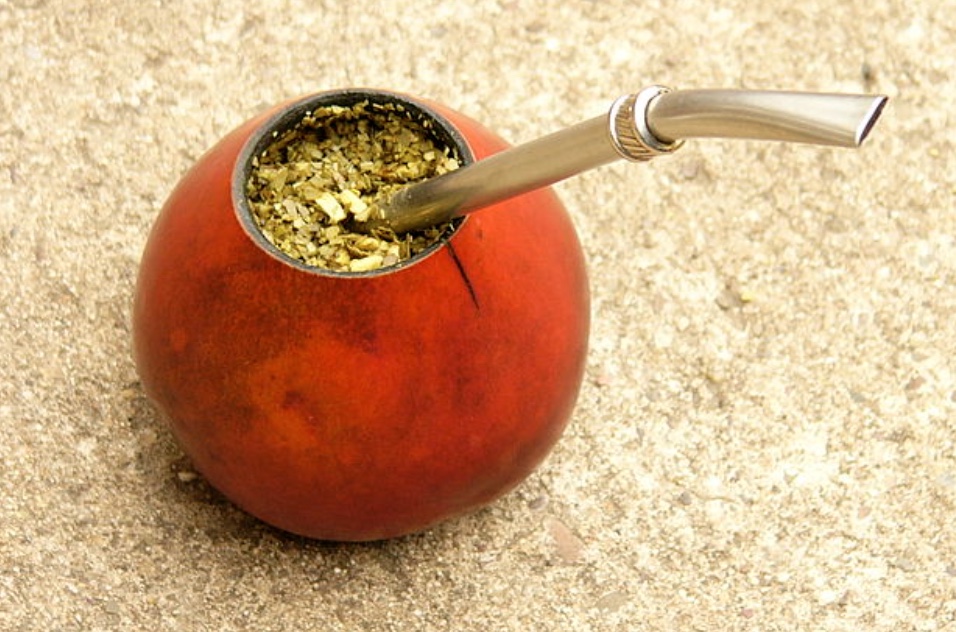Yerba maté: A Beverage’s Journey to the Middle East

By: Fedal Hanoun / Arab America Contributing Writer
Yerba maté, a classic South American drink, has captured palates and cultures around the world. This energizing infusion, which originated in the country of Argentina, has traveled an incredible voyage to the Middle East, where it has established an extraordinary place for itself. This article delves into the roots of yerba maté in Argentina and its following trip to the Middle East, exploring the societal and cultural influences that led to its popularity worldwide.
The Origins of Yerba maté in Argentina
For decades, the dried leaves of the Ilex paraguariensis tree have been the source of yerba maté, a crucial cultural element in South America. To produce yerba maté, a caffeine-rich beverage, people pick, dry, powder, and preserve the leaves. The leaves can be soaked in steaming water to produce maté.
The Guarani, the area’s indigenous inhabitants, are often associated with finding and producing the plant. Originally, they drank the beverage with a bombilla, a filter-equipped metal straw still in use today. The bombilla‘s unique shape protects consumers from boiling water and accidentally ingesting yerba maté leaves and stems. Millions of Argentinians enjoy it daily, often sharing it with relatives and close friends. This communal aspect of yerba maté drinking has been critical to its long-term appeal.
The Journey to the Middle East
A fascinating story of cultural interchange and migration, the journey of yerba maté to the Middle East is a rich source of learning. Despite the fact that the precise timing is unknown, it is generally accepted that the beverage was initially introduced to the area sometime between the 19th and early 20th centuries.
There are a number of causes that are believed to have contributed to its introduction. One of these elements is the flood of South American immigrants to the Middle East, mainly from Argentina and Paraguay. These immigrants took their cultural traditions and agricultural practices with them, including yerba maté. Furthermore, the Middle East has an extensive tradition of cultural interchange with other parts of the world, which may have played a role in the arrival of this South American drink. Additionally, the growing recognition of South American items in the Middle East might have also played a part since increased commerce made yerba maté readily available to customers. This may have been contributing to the phenomenon.
Adapting to New Cultures
After establishing itself in the Middle East, yerba maté was confronted with the task of adjusting to an unfamiliar cultural setting. In order for it to be accepted, it needed to cater to the tastes and habits of the locals. Despite the fact that the basic process of production remained comparable to that which is utilized in South America, various adjustments were made in order to accommodate the preferences of the local community. For instance, in some regions of the Middle East, yerba maté is typically sweetened with sugar or honey, while in other nations, it may be blended with spices such as cinnamon.
Yerba maté has been able to preserve both its unique taste and its cultural value regardless of the modifications that have been made to it. Because of its naturally occurring caffeine amount and any potential health advantages it may offer, it has grown into an increasingly common option among customers in the Middle East who are concerned about their healthy lifestyle. Furthermore, the social side of yerba maté has struck a chord with the cultures of the Middle East, which place a great priority on generosity and the exchange of experiences.

The Future of Yerba maté in the Middle East
As international markets continue to grow, there is a favorable chance that yerba maté will become even more popular in the Middle East. Because of its one-of-a-kind flavor characteristics, cultural importance, and the possibility that it may be beneficial to one’s health, it is an appealing choice for consumers who are looking for new and intriguing beverages.
Despite this, difficulties still exist. One of the most major challenges is the restricted supply of yerba maté in certain nations located in the Middle East. The importers and distributors of the product have to collaborate together to improve the availability of the drink while making it easier to get for customers in order to solve this challenge.
In the end, the trip that yerba maté took from its beginnings in Argentina to the Middle East is a demonstration of the power of cultural interaction as well as the lasting appeal of some beverages. It is conceivable that this South American beverage will play a more vital part in the social and cultural environment of the Middle East as it proceeds to acquire prominence in this part of the world.
Check out our blog here!








